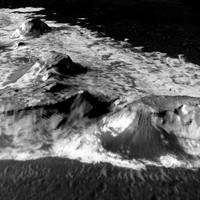
Moon and Mars Terrain Reconstruction
Tags: cartography, mars, moon, nasa, vision
The flagship application for the NASA Vision Workbench has been the Ames Stereo Pipeline, a stereo correlation and 3D reconstruction tool geared towards both rover stereo cameras and especially orbiting satellite imagers. It uses the Vision Workbench for all of its image processing and geometric calculations, including especially the Stereo module to perform the core stereo correlation computation. My role in all of this has mostly been developing and supporting the core underlying image processing framework, though i took an early pass at refactoring the stereo code when we first brought it into the Vision Workbench and I guided the evolution of that code towards its current highly-scaleable architecture as the “view” concept in the Vision Workbench came into sharper focus.
 In any case, the Stereo Pipeline bangs out some pretty impressive 3D models from orbital imagery. The top image is actually a screenshot from a show at the Hayden Planetarium in New York, where they used some of our terrain. If you look closely you can see the boundary between our terrain and the global data, which does a far less impressive job of revealing the dramatic Lunar landscape. The source imagery for that terrain patch was the Apollo Panoramic Camera, a modified spy camera that flew on the orbiter during Apollo missions 15, 16, and 17. It has a particularly funky mechanical design that is especially difficult to model accurately. I spent a while trying to tune a model for it, but I was never entirely happy with the results, and so far nobody has succeeded in building a model that really captures all of the camera's quirks.
In any case, the Stereo Pipeline bangs out some pretty impressive 3D models from orbital imagery. The top image is actually a screenshot from a show at the Hayden Planetarium in New York, where they used some of our terrain. If you look closely you can see the boundary between our terrain and the global data, which does a far less impressive job of revealing the dramatic Lunar landscape. The source imagery for that terrain patch was the Apollo Panoramic Camera, a modified spy camera that flew on the orbiter during Apollo missions 15, 16, and 17. It has a particularly funky mechanical design that is especially difficult to model accurately. I spent a while trying to tune a model for it, but I was never entirely happy with the results, and so far nobody has succeeded in building a model that really captures all of the camera's quirks.
The image at the left is of the Terra Meridiani on Mars. It was generated from images taken by the Mars Orbiter Camera (MOC) on board the Mars Global Surveyor satellite. When we first got into this business, processing a complete pair of MOC images seemed like a big deal. Now they seem so small! These days we're able to process gigapixel stereo pairs on a single computer, and we're just beginning to use NASA’s Columbia supercomputer to process huge sets of high-resolution images all at once.



